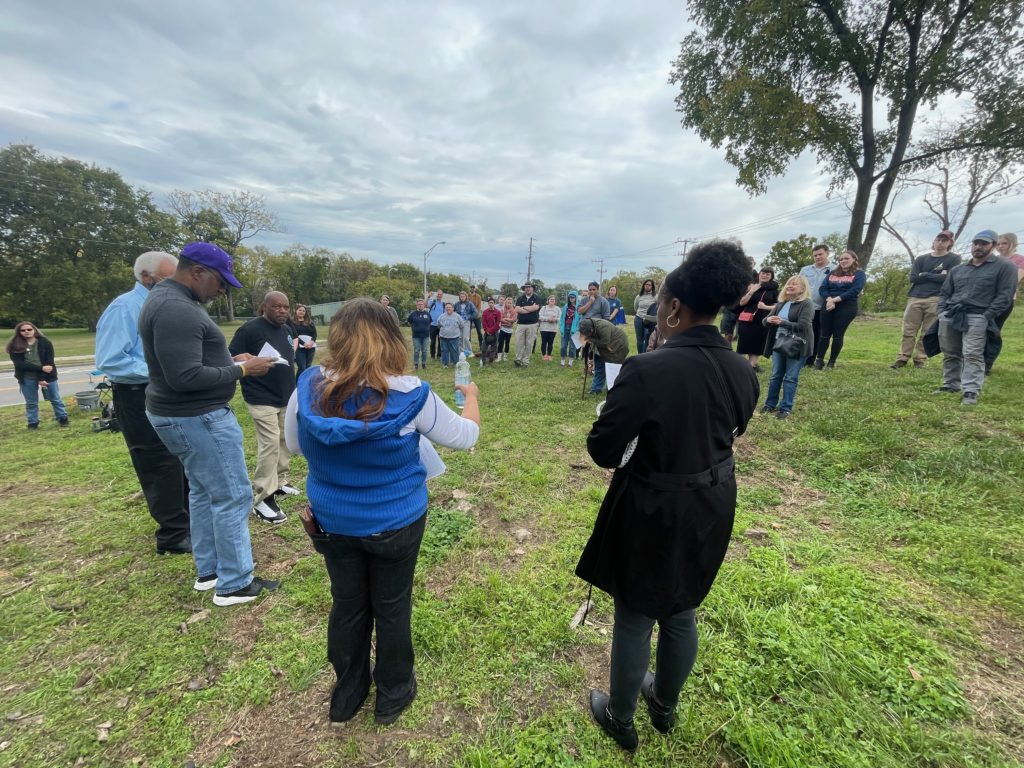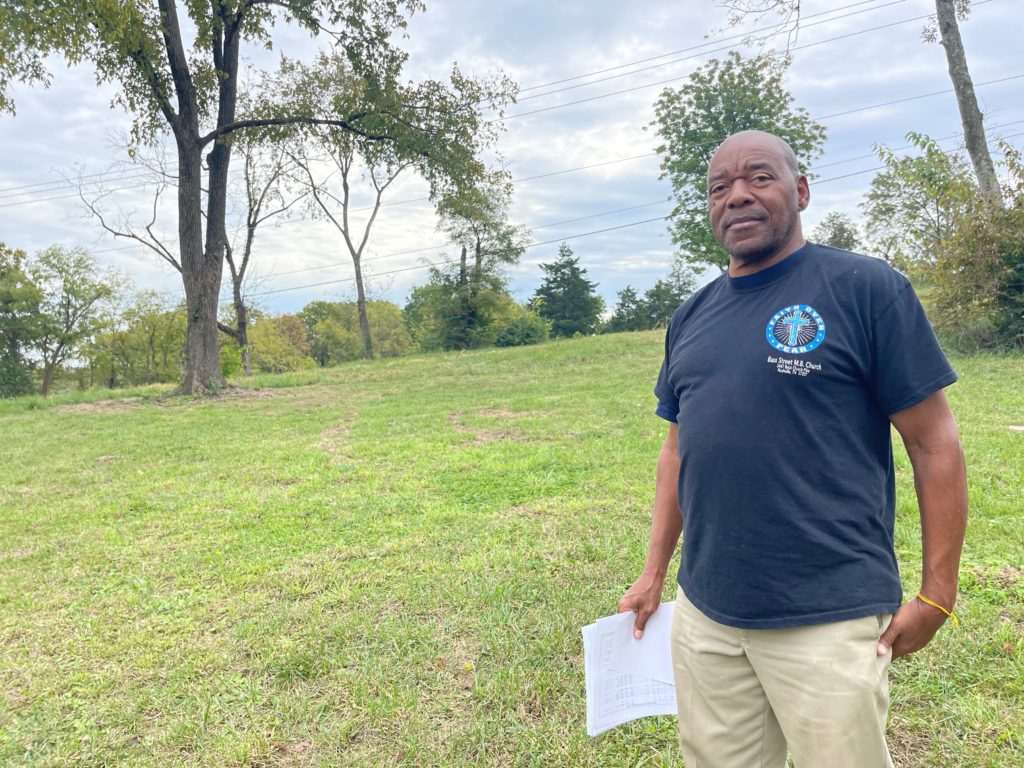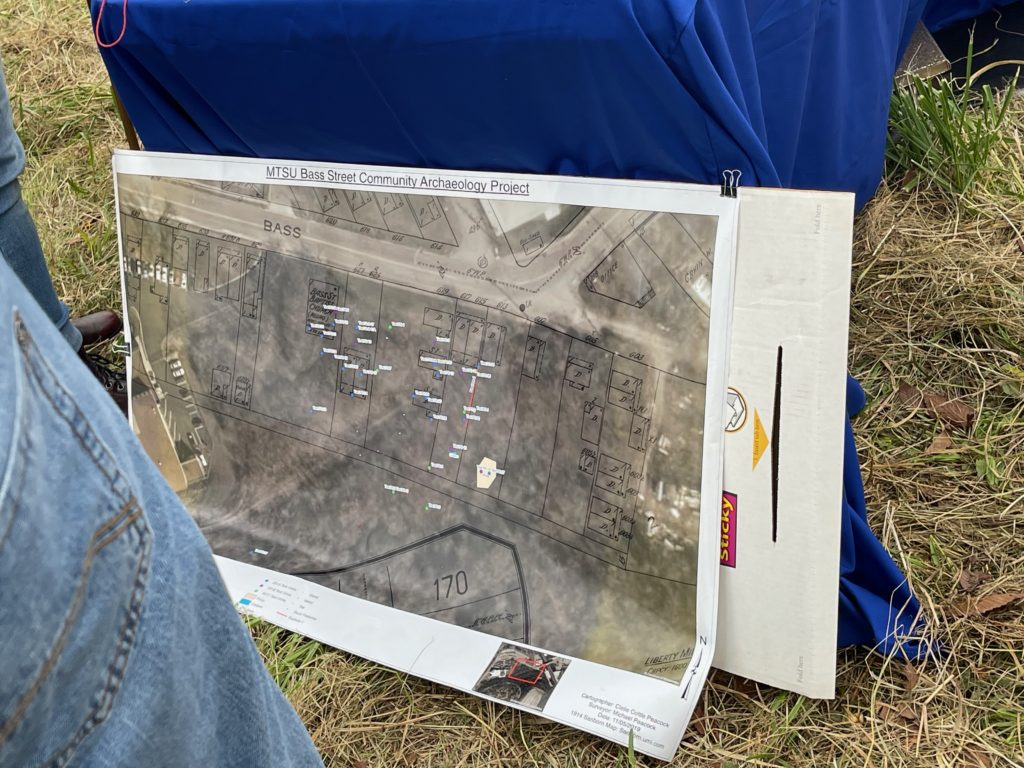
This story first aired on our daily show, This Is Nashville. Listen to the entire episode on Bass Street and Fort Negley here.
The Bass Street Baptist Church once stood at the foot of St. Cloud Hill. The surrounding area was settled first by some of the formerly enslaved people who had helped build Fort Negley — the largest inland stone fortification of its era — and defend it against the Confederacy. This became known as the Bass Street neighborhood, Nashville’s first post-Emancipation Black neighborhood.
Today, Bass Street is barely a street at all, a stretch of just a thousand feet or so, and the original church structure is long gone, along with the houses that once stood here. Above, the Adventure Science Center sits on the north face of the hill, and Fort Negley still stands on the south side.
Back in October, a small group gathers at the old church site, including conservationists, historians, some of the archaeologists who had unearthed pieces of the church’s foundation and former residents, like Phillip Minter.
 Khalil Ekulona, WPLN
Khalil Ekulona, WPLN Former Bass Street resident Phillip Minter remembers being displaced from the neighborhood.
“Growing up, I lived right across the street right there where that pole is,” Minter says. “My grandparents lived up here. We had a double outhouse that everyone on this side of the street had to use that, that bathroom, until they built a house across the street.”
A note about that outhouse: The city didn’t run plumbing or electricity to this area. But that didn’t stop residents from having fun and being kids.
“I played all back up in through there,” Minter says. “That was … my stomping grounds. So that’s where I played at, and this right here was where the church was.”
A church at the center
Minter says the church was the community. His grandfather was a deacon there.
Vernice Scruggs remembers him well.
“He never missed a service,” Scruggs says.
Minter’s grandfather wasn’t just reliable; he was also incredibly strong. He was a double amputee who used a wheelchair, which sounds like it might have been a challenge, given the church sat at the base of one very steep hill. But Scruggs says it was no problem.
“His grandfather, with no legs, would roll down the hill, roll the wheelchair to the foot of the steps, sit on the steps, then scoot himself up the stairs with the wheelchair in one arm,” Scruggs remembers. “He’d go and go, and then he’d get back in the wheelchair.”
 Khalil Ekulona, WPLN
Khalil Ekulona, WPLN Vernice Scruggs, former Bass Street resident
Scruggs attended these services nearly every Sunday and remembers what it was like in the early days.
“When the church was first built, it was just a dugout,” Scruggs says. “We had service in the basement for years, up until the early ’40s.”
That’s when the upper part of the church was finally finished. Back then, as Scruggs recalls, the church “was the last thing on the hill beside the fort.”
A lot has changed since then. The church was torn down, though it kept its name through several relocations. (Bass Street Baptist Church is now located on Brick Church Pike, after many years on 12th Avenue South and several temporary locations at various other points.)
Back when the church was there at 627 Bass Street, Scruggs remembers exploring the area as a kid every Sunday.
“We couldn’t wait for Sunday school to be out on Sunday morning — a whole bunch of us kids would run up and explore the fort, and everything was on the fort at that time. Even some old cannons and old mini-balls. All kinds of war stuff were still strewn all over the place. Little by little, they kind of cleaned it up and took it over to the museum.”
A legacy in ruins
It was really only because of the conversations they had at home that Scruggs knew anything about Fort Negley and its significance at all.
“They never really talked about the Battle of Nashville a lot in school,” Scruggs says, “Nobody ever talked about it in detail … They never even mentioned that it was actually the Black soldiers that built this fort and actually defended it.”
This kind of erasure took shape in more ways than one. Part of the reason the Bass Street Baptist Church had to move is the installment of Interstate 65. Urban renewal split the thriving Bass Street neighborhood right in half.
“They cut all these houses out and brought the interstate through here,” Minter says. “And that’s when they made all us move to the housing projects.”
Asked if residents tried to fight back, Minter responds, “We couldn’t fight it. It wasn’t no fight … We had to move. They told us that’s the way it is … You know, just the bottom line.”
“Our house could have still been right there, right today,” Minter says as his eyes search an area that is now a parking lot. “I’m just sitting back looking, you know, our house could have still been right there.”
 Khalil Ekulona, WPLN
Khalil Ekulona, WPLN A map showing parcels in the Bass Street neighborhood, including the original location of the Bass Street Baptist Church
Remembering the past
At the gathering, Rev. Daryl Thompson, from the present-day Bass Street Baptist Church, offers a short prayer.
“Too many times, history is just wiped out for the sake of the advancement of tomorrow,” he says. “And we throw away yesterday. And so thank you so much for holding on to it for us.”
Reverend Thompson is just one of many gathered in an effort to set the record of this place, and to keep its history alive — in part, with a naming ceremony, led by Jeneene Blackman from the African American Cultural Alliance.
“We do a little ceremony where we invite our ancestors here,” Blackman says. “It’s just a way to acknowledge their presence. And the first time I came here, I actually felt I still feel them. … I feel like that land is being healed — Fort Negley as well as this land — because so many things happened here that was unpleasant, but I feel like the land is actually being healed.”
“So we’re going to call the names,” she continues, “and after every name, or family group, we’ll say ‘ashe.’”
In all, Blackman reads more than 40 names — mothers, fathers, grandparents, children. And at the end, Jeneene asks if anyone else has a name they want the group to recognize.
“I want to acknowledge my great great grandfather, U.S. Colored Troops,” someone says. “Peter Miller.”
The crowd responds: “Ashe.”


